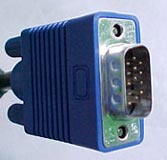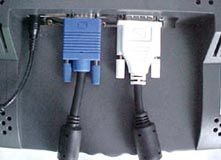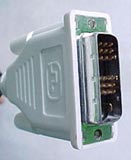LCD panels are very complex components to construct and
most manufactures only guarantee their display's to be 99.9% free from defect.
That means there can be up to 3 or 5 broken pixels before the display is
considered "broken." Broken pixels are individual pixels in the display panel
which are stuck on a certain colour, are constantly dim, or are always off.
Depending on the location and intensity of a broken pixel they can be next to
invisible, or glaringly obvious. The bottom line is that it pays to test the
display first, regardless of what manufacturer makes it.
Analog and DVI
Analog video connections are the type most
commonly in use at the moment. In fact, unless you have recently upgraded to the
newer all digital standard you are probably reading this review on a display connected
via and analog cable to an analog video card.
The truth that old
habits die hard has never ringed truer than with LCD displays.
When first introduced onto the market I seem to recall that just about every
display required nothing less than a digital output video card. At the time LCD displays
were incredibly expensive, and are now only starting come down in price as manufacturers
are able to produce less expensive LCD panels.
| Analog Connection |
(hand in hand) |
DVI Connection |
 |
 |
 |
The basic differences between the analog display adapter and the
DVI (digital) display adapter boil down to how the image is transmitted to your
monitor. In the first instance, the analog version, the image is sent to the monitor
as waveform (essentially). Since we're are accustomed to connecting a CRT display which operates
on analog principles this was the perfect match.
However, when these same analog signals
are sent to an LCD display - a device which only
operates on digital signals - the picture much be digitally encoded before it can
be processed and displayed. On the other hand, if you happen to be equipped with a
digital output on your video card, the digital signals are simply sent right to
the display to be shown on the screen.
While we couldn't detect any perceivable differences between the two types of video hook ups
in terms of display quality (both were excellent) there are a few operational
differences. An analog signal can be adjusted and tweaked to perfection, but a digital signal
is (or should be) coming to the display perfectly. Thus, while there are a great many
things you can configure on the display with regard to an analog hook up,
the choice is pretty slim when using DVI.
